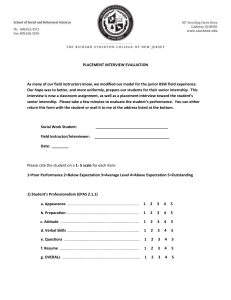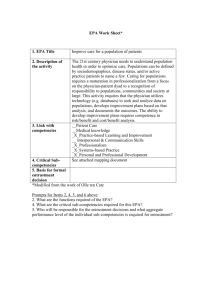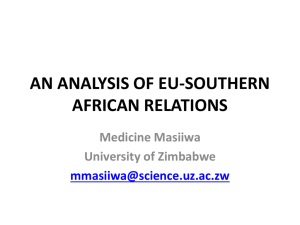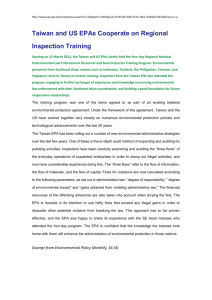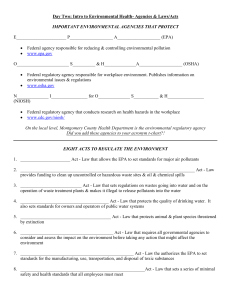Education Council (EC) Meeting Minutes March 19, 2013
advertisement
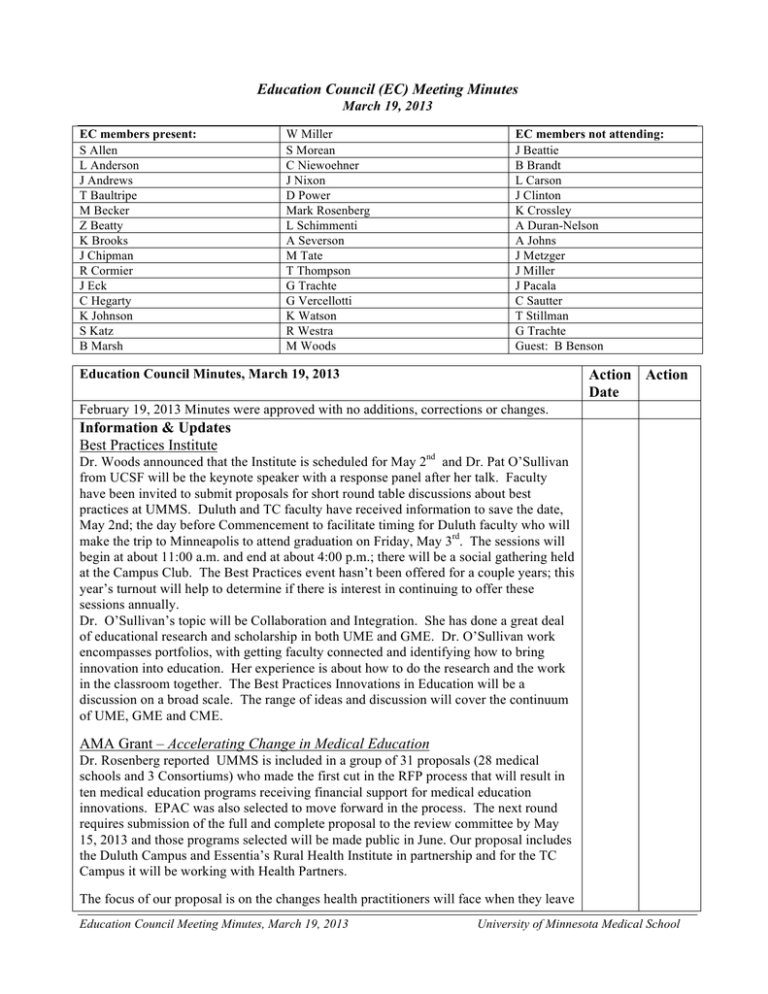
Education Council (EC) Meeting Minutes March 19, 2013 EC members present: S Allen L Anderson J Andrews T Baultripe M Becker Z Beatty K Brooks J Chipman R Cormier J Eck C Hegarty K Johnson S Katz B Marsh W Miller S Morean C Niewoehner J Nixon D Power Mark Rosenberg L Schimmenti A Severson M Tate T Thompson G Trachte G Vercellotti K Watson R Westra M Woods EC members not attending: J Beattie B Brandt L Carson J Clinton K Crossley A Duran-Nelson A Johns J Metzger J Miller J Pacala C Sautter T Stillman G Trachte Guest: B Benson Action Action Date Education Council Minutes, March 19, 2013 February 19, 2013 Minutes were approved with no additions, corrections or changes. Information & Updates Best Practices Institute Dr. Woods announced that the Institute is scheduled for May 2nd and Dr. Pat O’Sullivan from UCSF will be the keynote speaker with a response panel after her talk. Faculty have been invited to submit proposals for short round table discussions about best practices at UMMS. Duluth and TC faculty have received information to save the date, May 2nd; the day before Commencement to facilitate timing for Duluth faculty who will make the trip to Minneapolis to attend graduation on Friday, May 3rd. The sessions will begin at about 11:00 a.m. and end at about 4:00 p.m.; there will be a social gathering held at the Campus Club. The Best Practices event hasn’t been offered for a couple years; this year’s turnout will help to determine if there is interest in continuing to offer these sessions annually. Dr. O’Sullivan’s topic will be Collaboration and Integration. She has done a great deal of educational research and scholarship in both UME and GME. Dr. O’Sullivan work encompasses portfolios, with getting faculty connected and identifying how to bring innovation into education. Her experience is about how to do the research and the work in the classroom together. The Best Practices Innovations in Education will be a discussion on a broad scale. The range of ideas and discussion will cover the continuum of UME, GME and CME. AMA Grant – Accelerating Change in Medical Education Dr. Rosenberg reported UMMS is included in a group of 31 proposals (28 medical schools and 3 Consortiums) who made the first cut in the RFP process that will result in ten medical education programs receiving financial support for medical education innovations. EPAC was also selected to move forward in the process. The next round requires submission of the full and complete proposal to the review committee by May 15, 2013 and those programs selected will be made public in June. Our proposal includes the Duluth Campus and Essentia’s Rural Health Institute in partnership and for the TC Campus it will be working with Health Partners. The focus of our proposal is on the changes health practitioners will face when they leave Education Council Meeting Minutes, March 19, 2013 University of Minnesota Medical School medical school and enter residency to practice and how to help prepare them to address: • accelerating change in health systems practice • more focus on team based care • interprofessional education • working in quality environments • paying attention to the cost and patient care experience The health systems, the medical school and the AHC have committed to work together to develop better environments in which to train students, with more attention to quality. Dr. Rosenberg let the Council know the outcome in the next phase of selection. Innovations Proposal: Medical Innovations Contest Dr. Rosenberg announced a grassroots innovative idea contest within Medical Education. Anyone involved in education, whether a student, resident, fellow , staff, faculty, preceptor; is encouraged to submit an education idea. These proposed innovations will go to a central website where anyone can view them and everyone viewing will get three votes. Comments and individuals’ votes should reflect their favorite 3 ideas; the top five ideas (by count of votes) will be selected. Each of the five will be asked to flesh out their ideas more fully with the goal of funding the top 3 for about $15,000. First it is an attempt to make a culture change in medical education. The secondary purpose is to engage everybody; all votes are equal. The third reason is to generate some good ideas for how to make improvements using these themes; across the continuum, integration of the curriculum, active learning, and interprofessional education. Another focus is to encourage collaboration with others. Once the top ideas are identified the authors will be asked to write a full proposal, which will be reviewed a committee to make the selection. The technical details for posting, viewing and voting are in the works and once they are ready the request for ideas will go out to all areas of the medical school. Teamwork EPA (Entrustable Professional Activities) Dr. Kathy Watson provided background for the development of EPAs which began with a request to the Student Assessment Committee (SAC) about 9 months ago. Dr. Brian Benson the SAC chair and a team were asked to come up with one or more EPAs that could be used across the continuum with the focus beginning in UME. The group, with members from both the Duluth and TC campuses has been working together since receiving this request. Dr. Benson noted the theme focused on concerns, voiced by healthcare providers, for the time required to retrain and acclimate our graduates as they enter their intern year of training. Dr. Benson gave an overview of the concept of milestones and EPAs, stating that the goal was to establish a milestone based assessment that connected to the continuum of medical education. The ACGME is an external driver with respect to use of milestones and EPAs and the group determined they would build on the work done at that level. Applying these concepts allows students to transition more quickly when beginning residency. The EPA Group did an independent analysis of our current UME assessments which was also supplemented by the data gathered for the LCME self study and site visit. He stated there are 4or 5 other Schools ahead of where UMMS is, in developing milestones and EPA’s but our School is well positioned to meet the challenge. The Group’s work reviewed UMMS’s milestones, competencies, and sub-competencies and narrowed it down to approximately the 15 they felt could be measured and tracked. These were mapped to our current competencies which they then mapped to assessment of the current curriculum. They have identified a target EPA; and they did develop a Milestone EPA. Education Council Meeting Minutes, March 19, 2013 University of Minnesota Medical School At this point they worked with Dr. Brandt (of the AHC) and she recommended the EPA Group expand their membership to include interprofessional members because the potential is to pilot this across other AHC Schools. Individuals from the School of Pharmacy and from Nursing were added and development of the EPA was broadened. In UME and GME there are language differences and finding the linkages to allow medical students to be familiar with those differences is key. For ACGME there are the 6 basic qualities desired in a physician and with steps being taken to map across competencies and subcompetencies the result will be the ability to determine if a doctor has demonstrated competence in all areas. Milestones are specifically observable behaviors that the learner should be able to demonstrate by a specific point in training. The end product of the Milestone Assessement is a description of the learner being reviewed; feedback from learners indicates an understanding where they’ve been , where they’re at and where they’re going. Self-assessment needs to be worked on to be developed and facilitated self-assessment can be successful. If the learner is informed of where they are in the continuum and provided with objective evidence it is successful. Using these with the struggling learner, this process makes it possible to break down the subcompetency to get at the specific piece the student isn’t understanding. These act as a roadmap for where MS1-4 needs to get to in their learning. This is basically the rationale for why this is the approach the ACGME is moving toward. Milestones provide guideposts and it forces the physician teachers to confirm this is what is seen as competence and excellence. In training often students see a variety of professional and clinical behaviors modeled, the competencies allow a standard to be set across the continuum, for students the message for where they’re going is clear and consistent. Entrustment is what takes place when the attending leaves the patients in the care of the learner physician. What skill level is necessary in order for the attending to feel the patient is in capable hands? It is specific about what is required and it allows everyone to know that the learner has met the standards established by the process. Objectively document that learners have skill equal to the trust that is being placed on them for patient care. Evaluators are asking attendings to state whether they trust this person to provide the specific level of patient care needed. Trust should be based on consistently satisfactory performance over time and at what levels. Milestones are essentially gradations of the subcompetencies, these then make up each of the EPAs. Assess the competence in the big activities; if they can do them this result infers competence in the subcompetencies and the milestones; because they have demonstrated that they can do those pieces. An example for Medical School is to define what the 16 EPAs are for medical student at the end of their training to be able to enter a residency program. Nationally, this defining is being done throughout medical education. The reason for this direction is they align what is assessed with what physicians do, they make sense to faculties, trainees, the public and they make explicit that bond which is trust. The EPA Work Group chose “teamwork” as a place to begin the process to define what are the key competencies required for effective teamwork. They began by using pediatric EPAs; previously Dr. Benson worked on a national pediatric group on these . In collaboration with Dr. Brandt they determined that factors of interprofessional collaboration (national collaboration under Dr. Brandt’s leadership) overlap with their initial set of EPAs and those have now been incorporated into the specific teamwork (see draft) competencies. He explained these have been mapped both ways using to seven U of MN competencies; and the “interprofessional” competencies ; and found there are large gaps. “Interprofessional teamwork” is such a new area and the Dr. Brandt’s group is defining what the field is, therefore the EPA Work Group decided that Education Council Meeting Minutes, March 19, 2013 University of Minnesota Medical School was why an “interprofessional EPA” would be added to the U of MN model for “teamwork” EPAs. Based upon they have developed a draft of a “teamwork EPA” which essentially breaks teamwork down into the “values and ethics, roles and responsibilities, specific communication skills, team organization and structure, and leadership, situation monitoring and mutual support”. They have described three levels of learner, which covers preclinical medical education through the clinical education. The EPA Work Group has added Pharmacy and Nursing colleagues to their sessions; each of the Group members is going back to the Educational Group they represent; i.e. the Faculty Advisors, the Duluth Campus, and the clerkships to help identify where to pilot. The next phase after consensus is reached will be to pilot it as an assessment tool. A grant has been submitted to find money to fund faculty training . Using the EPA materials being developed and looking at the skills required at each level it will be possible to write vignettes that describe what that learner looks like at each level. This clear description will then permit a video of a scenario of a student performing to be developed and training can take place across faculty and specialties to use as an assessment tool. The plan for the grant is to use this EPA to develop vignettes and then use them as on-line training for faculty who want to become raters of student performance based upon Entrustable Professional Activities. Over time this will allow standardization across the curriculum. Discussion points included the following: • The number of subcompetencies used with a competency will vary based on specificity of skill level. • Using factor analysis there will be pairings of subcompetencies together, the EPA Group is in the process of testing how to do that for “teamwork”. • What outcome is desireable in measuring if someone is trustable? Those things are part of the work that will need to be done to establish the EPAs; there is very little literature and Minnesota is poised to define the standards based on Dr. Brandt’s collaboration. • An opportunity to look at the continuum of entrustment regarding patient care. • Teamwork was selected by the EPA Group because it is difficult to define to be able to measure it. • UMMS’ work to define EPAs is at the front of the process across med educ • The reality is currently there isn’t a way to measure the “entrustment” that takes place in resident training. • An EPA is under development for “patient handoff” and requires direct observations of behavior by physicians. The promising result is that physicians are finding they can actually give direct feedback to be able for improvements. • Family medicine is going through the draft of NAS Milestones, which have just been released.to look at continuity from UME to GME. There is a national initiative on Primary Care Development in which the University is a participant. Medicine, Family Medicine and Pediatrics got a grant for training on a national level to train faculty how to teach teamwork. He and Brian Sic are faculty on that project and have developed it for Family Medicine, Medicine and Peds. The training will be shared across any specialties. • The competency based approach is a fundamental shift in medical education away from time limited education. • Use of the outcome of the EPA model establishes the question, “are we willing to not entrust people”. • Need an assessment system to support more accurate measurement to address readiness of learners across the continuum. Important for the students to understand while in the basic sciences, the aspect of Education Council Meeting Minutes, March 19, 2013 University of Minnesota Medical School entrustment and the differences when they are on a care team. For example, looking forward to when students experience the clinical care team, before then they need to understand the roles of other team members and their own place in team. Dr. Peter Southern’s (EPA Group member) perspective is that he sees early evidence of individuals who get what it is to be on a team, to mutually support each other; load sharing, and awareness when the external environment changes. He reported there are multiple areas within his course where opportunities exist to develop and assess team work for medical students across years 1 and 2. Clinicians would want for them to come in on day one of their first clinical rotation with a shared mental model of a team. There may be consideration directed toward developing EPAs to focus on specific areas such a cadaver group or problem based learning group. These have been used to monitor student progress in a clinical setting but used differently by different evaluators, i.e. using only a portion of the questions or applying them differently in relation to varying aspects of learning, small groups etc. Using the tool to gather performance data differently in year-1, another perspective in year-2 and on into year 3 and year 4. Ultimately tracking progress across the curriculum with specific focus of one EPA. It may be possible to have an integrated assessment tool that could be sorted into domains after the fact. The next step is to determine who is going to look at this progress to make the decision for how the learner is developing on that EPA, and someone to meet with them 1:1 to give them feedback. Suggestion that as a medical school before continuing to develop EPAs there should be a broader discussion for how it fits across the entire curriculum and how the evaluation will actually get done. This is an opportunity to determine these points: • whether we should continue to do competencies to milestones in an more deliberate manner • or does the School take the jump to the EPAs • select a few to develop and understand that they can be accomplished The AAMC is actually doing this and there is a group working on end of training EPAs for medical students. • this is part of a culture change to get to authentic assessment • this is a step closer but may not be the final answer • “entrustment is already happening” without authenticity • how many we use is a fine point to be decided • need to be culture change for students to operate more actively in team based patient care • this is a beginning approach and changes and improvements will be necessary An EPA related to working as a team makes good sense and external stakeholders are asking for changes in this particular area. EPAs bundles the ability to assess the “entrustment” across areas that are otherwise viewed separately and it’s an important piece that has to be accomplished early in residency and medical students can benefit from knowing it is an important component in the practice setting. As these are applied and rolled these are questions to consider: • how have faculty viewed it in relation to assessing their own progression • physicians realize there are areas where they do not do the work well • faculty will learn along with the students and have an opportunity to self assess • model to students what is required to achieve excellence Dr. Woods noted that the existence of EPAs over the next 5 to 10 years is going to challenge our culture as a medical school and how we think about the delivery of our curriculum and how we think about the delivery of our curriculum and how we consider Education Council Meeting Minutes, March 19, 2013 University of Minnesota Medical School the delivery of our curriculum and how we view where we place our students and our sites of excellence, how faculty are trained and how the students and the faculty work together. When considering all of the sites the issues multiply by the hundreds, for the questions whether students are being sent to the optimal place where they can learn with faculty who are involved and committed; and who understand it. If not should the School place more consideration on the delivery of the curriculum; there are some schools who are thinking about it. This has the potential for the School to have better faculty. The discussion included the possibility in the future to have faculty rate on teamwork as well. The informal curriculum to the students indicates a commitment by the faculty and the School to achieve excellence. Selecting the EPAs is important an important step at this point, but there should also be discussion for where will the next step be taken and how to choose the next step. The AAMC plans to share what they develop and they plan to take about a 2-year period before that is ready. The work group includes Carol Aschenbrenner and Bob Englander, have a reactor group and a core group doing the writing. Education Council Meeting Minutes, March 19, 2013 University of Minnesota Medical School
